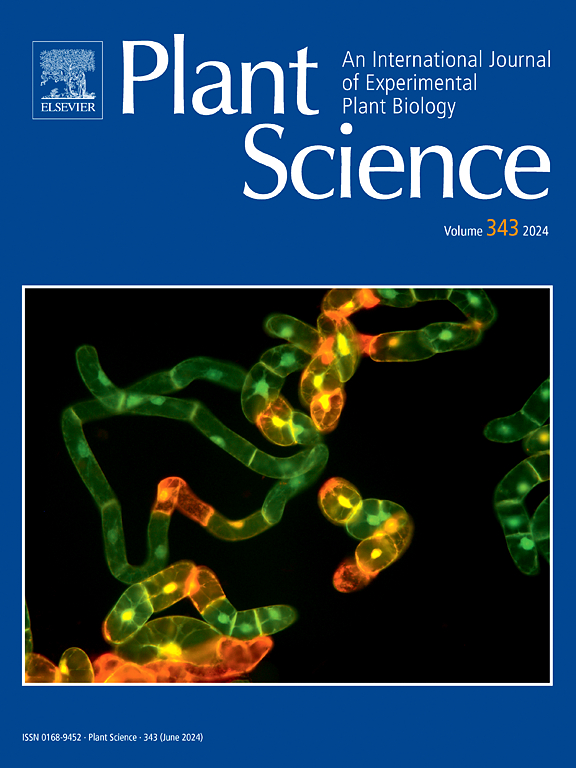Pyrus pyrifolia WRKY31 activates the ribosomal protein gene RPL12 to confer black spot resistance
IF 4.2
2区 生物学
Q2 BIOCHEMISTRY & MOLECULAR BIOLOGY
引用次数: 0
Abstract
Ribosomal proteins (RPs) are essential for genetic transcription and translation, playing a key role in plant growth, development, and stress responses, including disease resistance. However, the function and transcriptional regulation of RPL12 remain poorly understood. Investigating the gene function and the transcription factors that govern its expression is crucial to understanding its mechanism. In this study, a novel transcription factor gene, PpWRKY31, was isolated from Pyrus pyrifolia. The PpWRKY31 protein is expressed in the nucleus and belongs to Group IIb WRKY transcription factors. qRT-PCR analysis revealed that its expression was upregulated under the treatment of Alternaria alternata, as well as to exogenous hormonal treatments. Using yeast one-hybrid (Y1H) assay, dual-luciferase eporter assay, and electrophoretic mobility shift assay (EMSA), we demonstrated that PpWRKY31 can bind to the W-box element in the promoter region of PpRPL12. Overexpression of either PpWRKY31 or PpRPL12 enhanced the resistance of both pear and Arabidopsis thaliana plants to black spot disease, evidenced by reduced lesion size and increased activity of defense enzyme. Conversely, silencing of PpWRKY31 or PpRPL12 markedly diminished the resistance of pear to black spot disease. PpWRKY31 overexpression was observed to notably enhance the expression of PpRPL12 and genes associated with salicylic acid, inducing changes in the activity of enzymes related to the phenylpropanoid pathway, such as phenylalanine ammonia-lyase (PAL). In conclusion, this study elucidates a novel PpWRKY31-PpRPL12 signaling pathway that enhances resistance to pear black spot disease, providing insights into the regulatory networks underpinning plant defense responses.
Core
Pear black spot disease, caused by Alternaria alternata, seriously affects fruit quality and yield. We identified that PpWRKY31 transgenic calli responded to Alternaria alternata in pear. PpWRKY31 binds to the W-box cis-element of the PpRPL12 promoter, upregulating the expression of PpRPL12. The PpWRKY31-PpRPL12 regulatory module indirectly influences the downstream salicylic acid and phenylpropanoid pathways, ultimately enhancing the pear's black spot resistance.
Gene and accession numbers
The sequence information used in this study is available in the Pear Genome Database (http://peargenome.njau.edu.cn/), the National Center for Biotechnology Information (NCBI) database, and The Arabidopsis Information Resource, see Table S2.
梨叶WRKY31激活核糖体蛋白基因RPL12赋予黑斑病抗性。
核糖体蛋白(RPs)在基因转录和翻译中起着至关重要的作用,在植物生长、发育和逆境反应中起着关键作用,包括抗病性。然而,RPL12的功能和转录调控仍然知之甚少。研究基因的功能和调控其表达的转录因子对理解其机制至关重要。本研究从梨叶中分离到了一个新的转录因子基因PpWRKY31。PpWRKY31蛋白在细胞核中表达,属于IIb组WRKY转录因子。qRT-PCR分析显示,在交替稻瘟菌处理和外源激素处理下,其表达上调。通过酵母单杂交(Y1H)实验、双荧光素酶报告子实验和电泳迁移转移实验(EMSA),我们证实PpWRKY31可以结合到PpRPL12启动子区域的W-box元件上。PpWRKY31或PpRPL12的过表达增强了梨和拟南芥对黑斑病的抗性,表现为损伤大小减小和防御酶活性增加。相反,PpWRKY31或PpRPL12的沉默显著降低了梨对黑斑病的抗性。PpWRKY31过表达可显著增强PpRPL12和水杨酸相关基因的表达,诱导苯丙氨酸解氨酶(PAL)等苯丙氨酸途径相关酶的活性变化。总之,本研究阐明了一种新的PpWRKY31-PpRPL12信号通路,该信号通路增强了梨黑斑病的抗性,为植物防御反应的调控网络提供了见解。梨黑斑病是一种由交替孢霉(Alternaria alternata)引起的病害,严重影响果实品质和产量。结果表明,PpWRKY31转基因愈伤组织对梨褐交变病菌有应答。PpWRKY31与PpRPL12启动子的W-box顺式元件结合,上调PpRPL12的表达。PpWRKY31-PpRPL12调控模块间接影响下游水杨酸和苯丙酸途径,最终增强梨的黑斑病抗性。基因和登录号:本研究中使用的序列信息可从梨基因组数据库(http://peargenome.njau.edu.cn/)、国家生物技术信息中心(NCBI)数据库和拟南芥信息资源中获得,见补充表S2。
本文章由计算机程序翻译,如有差异,请以英文原文为准。
求助全文
约1分钟内获得全文
求助全文
来源期刊

Plant Science
生物-生化与分子生物学
CiteScore
9.10
自引率
1.90%
发文量
322
审稿时长
33 days
期刊介绍:
Plant Science will publish in the minimum of time, research manuscripts as well as commissioned reviews and commentaries recommended by its referees in all areas of experimental plant biology with emphasis in the broad areas of genomics, proteomics, biochemistry (including enzymology), physiology, cell biology, development, genetics, functional plant breeding, systems biology and the interaction of plants with the environment.
Manuscripts for full consideration should be written concisely and essentially as a final report. The main criterion for publication is that the manuscript must contain original and significant insights that lead to a better understanding of fundamental plant biology. Papers centering on plant cell culture should be of interest to a wide audience and methods employed result in a substantial improvement over existing established techniques and approaches. Methods papers are welcome only when the technique(s) described is novel or provides a major advancement of established protocols.
 求助内容:
求助内容: 应助结果提醒方式:
应助结果提醒方式:


